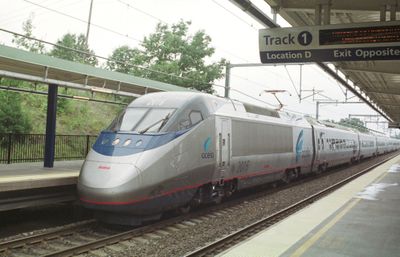High-speed rail gets new priority
States scramble to qualify for stimulus funding

WASHINGTON – The Northern Lights Express is little more than an idea – a proposal for a 110-mph passenger train between Minneapolis and Duluth, Minn., that has crept along in fits and starts for years.
But the slow ride may soon be over. The project is one of dozens nationwide that are likely to benefit from President Barack Obama’s initiative to fund high-speed and intercity passenger rail programs, including $8 billion in stimulus money and $5 billion more over the next five years in the administration’s proposed transportation budget.
The money represents the first major step toward establishing a genuine high-speed train network in the United States and has sparked a stampede among states, advocacy groups and lobbyists who are not accustomed to this level of funding.
“We’re going to turn over every stone we can,” said Steve Raukar, a commissioner in St. Louis County, Minn., who chairs the Northern Lights Passenger Rail Alliance, which is spearheading the drive for the $500 million project. “We’re trying to get everything moving as fast as possible with the understanding that this is a once-in-a-lifetime opportunity for funding.”
High-speed rail has emerged as the cornerstone of Obama’s ambitious attempt to remake the nation’s transportation agenda, which for half a century has focused primarily on building highways and roads. Nearly half of the $48 billion in stimulus money for transportation projects will go toward rail, buses and other non-highway projects, including $1.3 billion for Amtrak and its successful rapid rail service, Acela. The Transportation Department also would receive $2 billion more under Obama’s proposed 2010 budget, most of it for rail and aviation improvements.
The dream of rail backers is a nation connected by high-speed lines that would be faster and more convenient than driving or flying. For instance, a trip on a proposed 432-mile line between Los Angeles and San Francisco would take 2 1/2 hours.
But experts and government officials caution that despite the billions, the amounts are still not nearly enough to pay for the kind of sleek “bullet train” systems that crisscross Europe and Japan at speeds of 200 mph or higher. The California project, for example, would cost an estimated $45 billion, including $9 billion in state bonds that voters approved last year.
“It sounds like a lot of money to Americans, but it’s really just a start,” said James P. RePass, president of the National Corridors Initiative, a nonprofit rail advocacy group. “We’re not going to wake up in a year and see a bullet train. But we are going to see much faster service for relatively little money.”
Amid praise from rail and transit advocates, however, many Republicans have zeroed in on Obama’s high-speed train initiative as a prime example of government excess. In his response to the president’s address to a joint session of Congress last week, Louisiana Gov. Bobby Jindal said that the program represents “wasteful spending” and suggested that the bill included money for a proposed magnetic levitation, or maglev, line from Las Vegas to Disneyland in Anaheim, Calif. The project could be eligible for such funding, but it is not named in the bill.
Administration officials say the rail initiative is particularly important to Obama, who routinely talked about the benefits of high-speed passenger service during the presidential campaign and who initially requested $10 billion in stimulus money for such projects.
The next step is doling out the money. The Federal Railroad Administration, which distributed $30 million for similar grants last year, is scrambling to develop guidelines for the program within the next six weeks, officials said.
“We are pulling in staff from all over the department to help with this,” said one senior transportation official, who spoke on the condition of anonymity. “The department is allowing us free rein.”
Although railroads are a major player on Capitol Hill, most of the industry’s lobbying efforts have focused on freight trains rather than passenger rail. Of $44 million in lobbying expenditures by the railroad sector last year, less than $2 million was spent by companies or organizations focused on promoting high-speed passenger service, according to data from the Center for Responsive Politics. The handful of foreign companies that specialize in building rapid electrically powered trains, such as Bombardier of Montreal, also have relatively low profiles in Washington.
“High-speed and intercity passenger rail beyond Amtrak haven’t gotten a lot of attention from the federal government historically,” said Paul Dean, government affairs director for the American Public Transportation Association. “This is a new thing.”
Industry experts and passenger-rail advocates say the strongest candidates for funding come from three areas of the country with the most developed plans for high-speed rail service: California, the Washington-New York-Boston corridor, and the web of rail lines centered around Chicago.
Laura Kliewer, director of the Midwest Interstate Passenger Rail Commission, said her organization identified $815 million in short-term projects that could be started almost immediately in the 10 states that belong to the organization. The group has also identified $15 billion worth of longer-range projects, including a $9 billion proposal to provide 110-mph train service between Chicago and eight states.